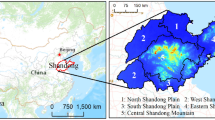Abstract
In this paper we establish a model that expresses the coupled relationship between grain yield and agricultural labor changes in China, and present a preliminary discussion of the coupled processes involved in changes in these factors at the county level. Thus, we develop two coefficients on the basis of county-level statistical data for grain yield and agricultural labor for the years 1991, 2000, and 2010, namely, the grain-labor elasticity coefficient (GLEC) and the agricultural labor-transfer effect coefficient (ALTEC). The results of this study show that during the transformation process of agricultural development in China, different kinds of coupled relationships between grain yield and agricultural labor changes co-existed at the same time. For example, between 1991 and 2010, counties characterized by three different coupled modes (i.e., increasing grain yield and decreasing agricultural labor, increasing grain yield and agricultural labor, and decreasing grain yield and agricultural labor) account for 48.85%, 29.11%, and 19.74% of the total across the study area, respectively. Interestingly, a coupled relationship between increasing grain yield and decreasing agricultural labor is mainly concentrated in the traditional farming areas of China, while a coupled relationship between increasing grain yield and agricultural labor is primarily concentrated in pastoral areas and agro-pastoral ecotones in underdeveloped western China. At the same time, a coupled relationship between decreasing grain yield and agricultural labor is concentrated in areas that have experienced a rapid development transition in agriculture, especially the developed southeastern coast of China. The results of this study also show that between 1991 and 2010, 1961 counties experienced a decline in the proportion of agricultural labor; of these, 1452 are also characterized by increasing grain yield, 72.38% of the total. This coupled relationship between grain yield and changes in the proportion of agricultural labor shows a stepped fluctuation and has continually strengthened over time. Data show that mean values for the GLEC and ALTEC increased from–0.25 and–2.93 between 1991 and 2000 to–0.16 and–1.78 between 2000 and 2010, respectively. These changes in GLEC and ALTEC illustrate that the influence of agricultural labor changes on increasing grain yields has gradually diminished. Finally, the results of this study reveal that the ‘Hu Huanyong Line’ is a significant boundary sub-dividing this coupled relationship between grain yield and changes in agricultural labor.
Similar content being viewed by others
References
Chan K W, 2010. A China paradox: Migrant labor shortage amidst rural labor supply abundance. Eurasian Geography and Economics, 51(4): 513–530.
Chen Y, Li X, 2013. Spatial-temporal characteristics and influencing factors of grain yield change in China. Transactions of the Chinese Society of Agricultural Engineering, 29(20): 1–10. (in Chinese)
Chen Y, Li X, Tian Y et al., 2009. Structural change of agricultural land use intensity and its regional disparity in China. Journal of Geographical Sciences, 19(5): 545–556.
Christiansen F, 2009. Food security, urbanization and social stability in China. Journal of Agrarian Change, 9(4): 548–575.
Clay D, Reardon T, Kangasniemi J, 1998. Sustainable intensification in the highland tropics: Rwandan farmers’ investments in land conservation and soil fertility. Economic Development and Cultural Change, 46(2): 351–377.
De Janvry A, Sadoulet E, Zhu N, 2005. The role of non-farm incomes in reducing rural poverty and inequality in China. CUDARE Working Paper 1001, Berkeley: University of California.
Gao L, Huang J, Rozelle S, 2012. Rental markets for cultivated land and agricultural investments in China. Agricultural Economics, 43(4): 391–403.
Gu L, 2013. Relative analysis of China’s grain yield and influence factors based on criterion of least absolute deviation. Transactions of the Chinese Society of Agricultural Engineering, 29(11): 1–10. (in Chinese)
Heerink N, Qu F, Kuiper M et al., 2007. Policy reforms, rice production and sustainable land use in China: A macro-micro analysis. Agricultural Systems, 94(3): 784–800.
Lewis A W, 1989. Dual Economy. Beijing: Beijing Economic College Press. (in Chinese)
Li L, Wang C, Segarra E et al., 2013. Migration, remittances, and agricultural productivity in small farming systems in Northwest China. China Agricultural Economic Review, 5(1): 5–23.
Lin J Y, 1992. Rural reforms and agricultural growth in China. The American Economic Review, 82(1): 34–51.
Lipton M, 1980. Migration from rural areas of poor countries: The impact on rural productivity and income distribution. World Development, 8: 1–24.
Liu Y, Li Y, 2010. Spatio-temporal coupling relationship between farmland and agricultural labor changes at county level in China. Acta Geographica Sinica, 65(12): 1602–1612. (in Chinese)
Long H, 2014. Land consolidation: An indispensable way of spatial restructuring in rural China. Journal of Geographical Sciences, 24(2): 211–225.
Long H, 2015. Land use transition and land management. Geographical Research, 34(9): 1607–1618. (in Chinese)
Long H, Li Y, Liu Y et al., 2012. Accelerated restructuring in rural China fueled by ‘increasing vs. decreasing balance’ land-use policy for dealing with hollowed villages. Land Use Policy, 29: 11–22.
Long H, Tu S, Ge D et al., 2016. The allocation and management of critical resources in rural China under restructuring: Problems and prospects. Journal of Rural Studies, 47: 392–412.
Lu W, Mei Yan, Li Y, 2008. Regional change in China’s grain production: Effects of labor-land ratio, off-farm employment opportunities and labor compensation. Chinese Journal of Population Science, (3): 20–28. (in Chinese)
Oseni G, Winters P, 2009. Rural nonfarm activities and agricultural crop production in Nigeria. Agricultural Economics, 40(2): 189–201.
Qi L, 2007. Development Economics. Beijing: Higher Education Press. (in Chinese)
Ranis G, Fei J C H, 1969. A theory of economic development. American Economic Review, 51(4): 533–565.
Rozelle S, Taylor J E, DeBrauw A, 1999. Migration, remittances, and agricultural productivity in China. The American Economic Review, 89(2): 287–291.
Shao J, Zhang S, Li X, 2014. Farmland marginalization in the mountainous area: Characteristics, influence factors and policy implications. Acta Geographica Sinica, 69(2): 227–242. (in Chinese)
Song J, Wang E, 2001. The mode and tendency of agriculture surplus labor force transformation in China. Chinese Journal of Population Science, (6): 46–50. (in Chinese)
Taylor J E, López-Feldman A, 2010. Does migration make rural households more productive? Evidence from Mexico. The Journal of Development Studies, 46(1): 68–90.
Tian Y, Li X, Chen Y et al., 2010. A review on research advances in farm labor migration and its impacts on farm land use. Journal of Natural Resources, 25(4): 686–695. (in Chinese)
Wang X, Han L, Huang J et al., 2016. Gender and off-farm employment: Evidence from rural China. China & World Economy, 24(3): 18–36.
Wang X, Huang J, Rozelle S, 2017. Off-farm employment and agricultural specialization in China. China Economic Review, 42: 155–165.
Wu Y, 2010. Calculation on the elasticity of agricultural input-output in China: Based on spatial econometrics models. Chinese Rural Economy, (6): 25–37. (in Chinese)
Yan J, Yang Z, Li Z et al., 2016. Drivers of cropland abandonment in mountainous areas: A household decision model on farming scale in Southwest China. Land Use Policy, 57: 459–469.
Yan J, Zhang Y, Hua X et al., 2016. An explanation of labor migration and grain output growth: Findings of a case study in eastern Tibetan Plateau. Journal of Geographical Sciences, 26(4): 484–500.
Zhang X, Yang J, Wang S, 2011. China has reached the Lewis turning point. China Economic Review, 22(4): 542–554.
Zheng H, Tong J, Xu Y, 2007. Spatio-temporal changes of farmland resources and their driving forces in developed areas. Transactions of the Chinese Society of Agricultural Engineering, 23(4): 75–78. (in Chinese)
Zou J, Long H, 2009. The variation of farmland use and the security pattern of grain production in China since 1978. Journal of Natural Resources, 24(8): 1366–1375. (in Chinese)
Author information
Authors and Affiliations
Corresponding author
Additional information
Foundation: Key Program of National Natural Science Foundation of China, No.41731286; The National Key Technology R&D Program of China, No.2014BAL01B05
Rights and permissions
About this article
Cite this article
Ge, D., Long, H., Zhang, Y. et al. Analysis of the coupled relationship between grain yields and agricultural labor changes in China. J. Geogr. Sci. 28, 93–108 (2018). https://doi.org/10.1007/s11442-018-1461-5
Received:
Accepted:
Published:
Issue Date:
DOI: https://doi.org/10.1007/s11442-018-1461-5




